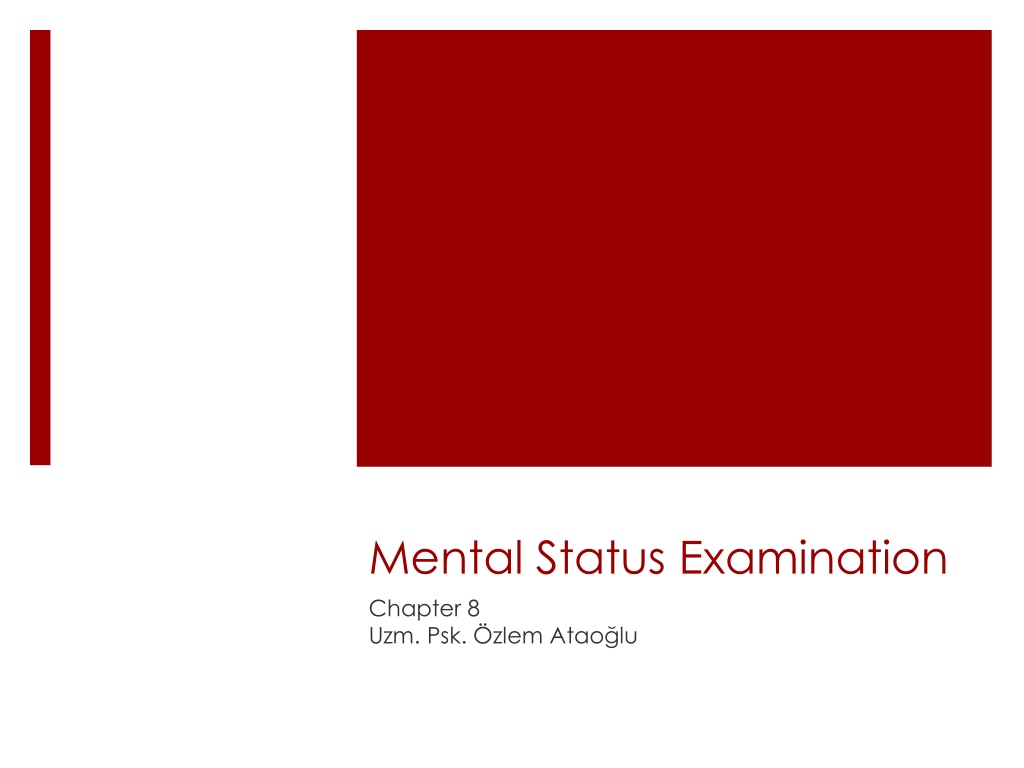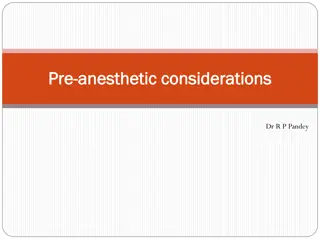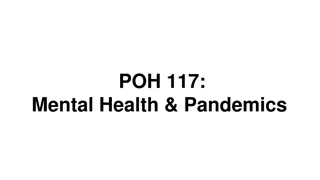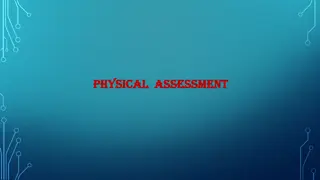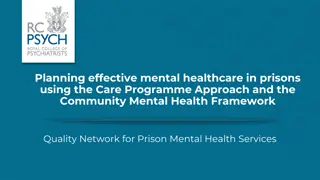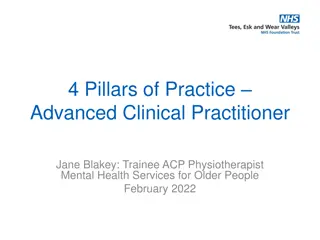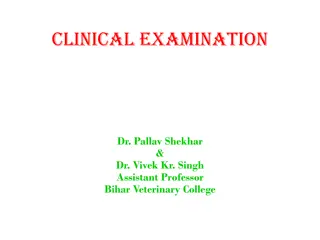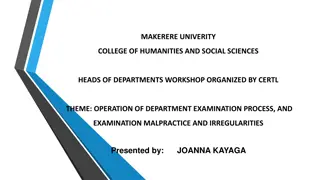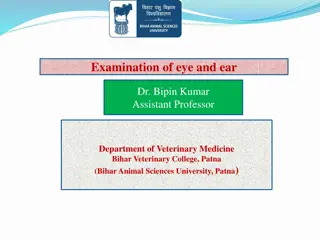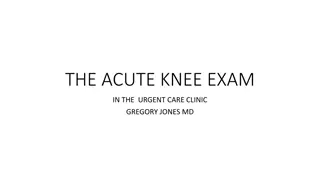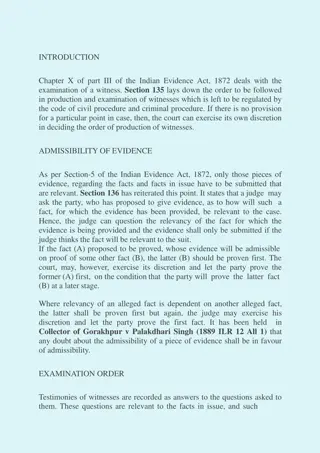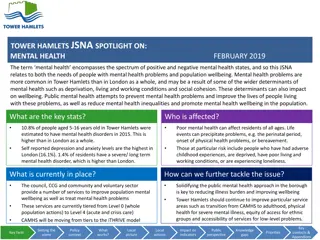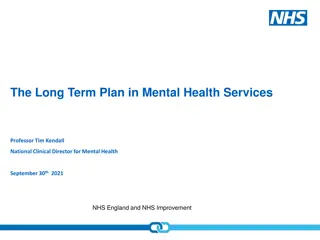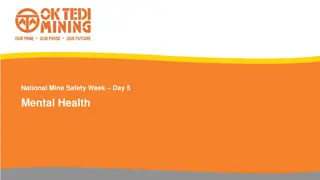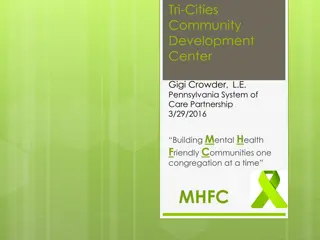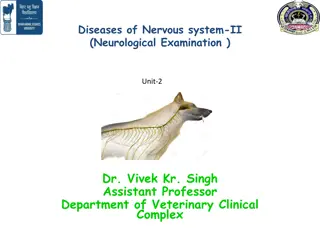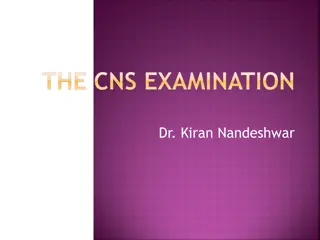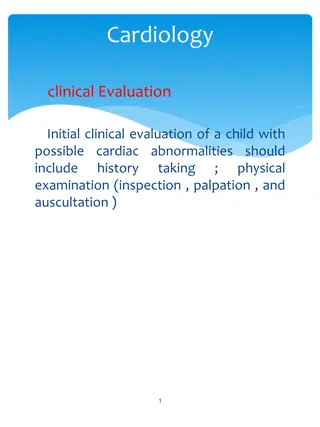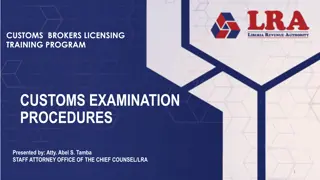Mental Status Examination (MSE) in Clinical Practice
Mental Status Examination (MSE) aims to assess cognitive processes, behavior, and emotions in patients with severe psychiatric conditions. The MSE includes evaluating outlook, psychomotor activation, attitude, memory, concentration, perception, cognition, speech, affect, behavior, and insight. Physical appearance and psychomotor activation are key aspects to observe during the assessment, providing insights into potential psychiatric diagnoses. Illustrated examples showcase the importance of noting physical attributes and behaviors to aid in diagnosis.
Download Presentation

Please find below an Image/Link to download the presentation.
The content on the website is provided AS IS for your information and personal use only. It may not be sold, licensed, or shared on other websites without obtaining consent from the author. Download presentation by click this link. If you encounter any issues during the download, it is possible that the publisher has removed the file from their server.
E N D
Presentation Transcript
Mental Status Examination Chapter 8 Uzm. Psk. zlem Atao lu
What is Mental Status Examination (MSE)? With MSE, we try to organize and evaluate the patient s mental status and our clinical observation under the existent circumstances Our primary goal is to evaluate cognitive processes We generally use MSE in medical settings whose psychiatric conditions are severe You have to know how to report MSE it is very common (everyday procedure) in mental hospitals
Mental Status Examination Outlook (Apperance) Psychomotor Activation Attitude towards interviewer Consciousness Orientation Memory Attention and Concentration Perception Cognition and Speech Affect/Mood Behaviour Insight
Outlook (Appearance) You should take notes about the appearance of the patient Sometimes you can include demographical information as well, if it is related What is included? Physical characteristics Self care Clothes Make up Piercing / Tattoo Height / Weight Facial expressions Sweat, trimmer, cold, etc.
You should be careful about these before you start to your interview Physical appearance can be sign of psychiatric diagnose. Example? Ece Ta k n, 24 ya nda, Eski ehir den g r meye geliyor. Ya ndan daha ya l g z kmektedir. zbak m yerindedir. Abart l bir makyaj yapt g zlemlenmi tir. K yafetleri g r meye uygun, temiz ve d zg nd r. Boyu ve kilosu orant s zd r, a r kilosundan dolay diyetine dikkat etmedi i d n lm t r (fiziksel hastal k ruled out). G z konta ok kurmam t r. Ellerinin titredi i g zlemlenmi tir.
Psychomotor Activation This is about physical behaviours. You should be careful about them during the interview. Even if your patient denies his/her experiences, you can collect the signs from these activations What can be included? Eye contact Repetitive behaviours Physical behaviours Scanning Psychomotor retardation, etc.
Psychomotor activation can be a sign of a psychiatric diagnosis. Example? Retarded activation depression, schizophrenia, substance use; increased activation anxiety, bipolar disorder, substance use; scanning paranoid behaviour, etc. Didem Han m n g r me esnas nda s kl kla dikkatinin da ld , saatini, g mle inin yakalar n , sa lar n d zeltti i, k peleriyle oynad g zlemlenmi tir. Ayr ca g r me odas na ve g r meciye ara ara inceleyerek (ayr nt lara dikkat ederek) g z atmas dikkat ekmi tir
Attitude towards interviewer The reactions the patients give to the interviewer or the interpersonal behaviours Differences can be due to cultural variances or individual differences You should ask whether this behaviour is rare, give any harm to the patient or others, compatible, due to circumstances What can be included? Answers given by the patient How they are given (direct, delayed, indirect, etc.) Tone of voice Eye contact Posture
Some of the adjectives that can be used to define these attitudes angry, cooperative, hostile, inpatient, uninterested, manipulative, open, passive, seductive, skeptical, pessimistic, etc. Efe Bey in g r me esnas nda g z konta kurmad , sorulan sorular direkt cevap vermek yerine orada bulunmas n n onun istemedi i bir durum oldu unu Zaten buraya gelmem de ablam n iste iyle oldu. c mlesiyle belirtmi tir. Bu, g r me esnas nda pasif oldu una i aret etmektedir. Koltu a yay larak oturmu olmas g r meyle ilgisiz oldu unu g stermektedir. Zaman zaman baca n sallamas , birka defa Bitti mi? diye sormas sab rs z oldu unu g stermektedir.
Consciousness If your patient is under vegetative state, this means s/he is unconscious Consciousness has its levels to being unconscious Clouding of (cloudy) consciousness: Lack of full consciousness. Sensorial stimulus cannot create an exact perception. Orientation, attention and perception is damaged. There is psychomotor retardation, reactions are slowed down, cognition is confused. It is common in organic brain syndromes/disorders Delirium: Fear and hallucinations are basic factors. The patient is confused, anxious, restless, agitated; orientation is damaged. The patient can fee that s/he lives in a dream. Delusions can be observed. The table is wavy, can change within hours/days. The most common reasons substance, drug intoxication; metabolic disorders (diabetes); organic brain syndrome; secondary development due to sudden quit of alcohol
Stupor: Being almost unconscious. The patient cannot react or develop any awareness. The patient is mutated, akinetic but still conscious, reflexes are normal; eyes are open, can follow the visual stimulus; if it is closed, shows resistance to open them; can remember the memories from stupor state Coma: The most severe state of stupor. The patient is unconscious, cannot show any voluntary actions. The most common reasons diabetic coma, head trauma, uremic coma, acute alcoholism, opiates, etc.
Orientation It is aimed to evaluate whether the patient has an awareness about their state. We try to evaluate basic cognitive functioning Our basic questions to measure orientation are who, where, when. If the patient shows resistance to answer, changes to topic and if the other clinical observations support, this means that the patient has disorientation You can vary the questions according to the patient s level of intelligence, education, cultural background If the patient starts to show disorientation signs, s/he will first lose time, then place and then person awareness Before you start asking these orientation questions, use a swing question at the beginning
Adnz nedir? u anda neredeyiz? Bug n g nlerden ne? Eviniz hangi il ede? u anki cumhurba kan m z n ad nedir? Doktorunuzun ad nedir? Odan z hangi katta? Ka numaral oda? Bug n len yeme ini ka ta yediniz? Refakat inizin ad nedir? u an ka nc kattay z? Hangi mevsimdeyiz? Buraya geleli ka g n oldu?
You can use these words while reporting consciousness and orientation conscious, confused, blurry, unconscious, coma Melisa Han m uyan k (concsious); ki i, zaman, yer y nelimi yerinde. Alp Bey in bilinci kar k; ki i ve yer y nelimi yerinde (Ox2). Zaman tan mlayamam t r.
Memory It has 3 components working memory, short term memory, long term memory How do we measure memory? Size birazdan 3 kelime s yleyece im. Dikkatlice dinleyin. Ben bitirdikten sonra tekrarlaman z isteyece im. Tabak.. Elma.. Okul.. working memory 100 den geriye do ru 7 er 7 er kartarak say n, ben dur deyince durabilirsiniz. attention (can be number sequence), Bana torunlar n z n ismini sayabilir misiniz? orientation, drawing a clock any possible brain damage. All of these are also destructions, lasts 3 5 minutes Az nce size 3 kelime s ylemi tim, hat rl yor musunuz? Bana tekrar edebilir misiniz? short term memory Bana ilkokulda ya am oldu unuz bir an n z anlatabilir misiniz? , Evlilik tarihinizi hat rl yor musunuz? , niversiteye hangi y l girdiniz? , Do du unuz tarihte ba bakan kimdi? long term memory
lhami Bey sylenen 3 kelimenin tamamn tekrarlayabilmi tir. Bu anl k belle inin al t n g stermektedir. Say lar geriye do ru sayarken yaln zca iki i lem yapabilmi ve Zaten matematikte hi iyi olmad m ki diyerek bu alandaki yetersizli ini kabul etmi tir. Bu performans lhami Bey in dikkatinin bozuk oldu unu g stermektedir. Kelimelerden tabak ve okulu hat rlam olan lhami Bey, k sa s reli bellek testinde de yeterli performans g sterememi tir. Uzun s reli bellek testinde verdi i cevaplar n do rulu u e i taraf ndan onaylanm t r.
Confabulation: Making up or distorting stories. It can happen during calling the memories back from long term memory. Memories should be verified by a relative/parent/partner. It can happen if the patient feels under pressure to remember the certain details try not to force your patient for answers, s/he may try to give the answers you would like to hear If you are suspicious about confabulation, ask more objective questions that you can test its objectivity Mostly the patients with organic brain syndrome, head trauma, depression can show memory deficiency and confabulation
Amnesia: Loss of memory remembering past experiences partially or not remembering at all Fugue: It is mainly dissociation. Forgetting about the past and suddenly leaving home/office. Personal identity is confused or a new identity is adopted. After becoming conscious, s/he does not remember the things happened during the fugue stage.
Attention and Concentration Focusing on some of the parts of a story, maintaining the focus, the effort spent to focus on a part of a story You can ask your patient Bana d harfi ile ba layan 5 kelime s yleyebilir misiniz? , 100 den geriye 3er 3er sayar m s n z? , Kitap kelimesinin harflerini sondan ba a s yleyebilir misiniz? Distractability: The patient is not able to focus on a task, a little stimulus/distractor may cause loss of concentration Hypervigilance: Focusing on all of the inner and outer stimulus at the same time Selective inattention: Ignoring the stimulus that may create anxiety
Melis Hanmdan grme esnasnda 100den geriye 3er 3er saymas istenmi tir. 5 i lem yapt ktan sonra aniden duran ve ok ac kt n , koridorda bir ocu un a lad n s yleyen Melis Han m a devam etmesi s ylendi inde verilen g revi unutmu ve tekrarlanmas n istemi tir. Bu, Melis Han m da distraktibilite ve hipervijilans oldu una i aret etmektedir.
Perception Perception includes two factors hallucinations and illusions Hallucinations are false sensory experiences, it can appear in all of our 5 sensory organs. Most common one is auditory hallucinations. Hallucinations mostly appear in patients with schizophrenia, chemical intoxication and acute traumatic stress You should be very skeptical while questioning these areas
Size baz sorular soracam. Bunlar belki allmam, tuhaf durumlar olabilir sizin i in. Ayn zamanda ya ad n z durumlarla ok da benzerlik g sterebilir. Zaman zaman televizyondan, sosyal medyadan size y nelik konu uluyor ya da sizi hedef alarak payla mlar yap l yor gibi d nceleriniz oldu mu? Peki bu size mesaj veren ses/TV programc s ne demeye al yordu size? , Bu konu an bir kad n m ? , Siz bu konu an ki iyi tan yor musunuz? , Her zaman ayn ses mi yoksa sesler de i iklik g steriyor mu? , Ne kadar zamand r size konu uyor? Hepimizin ba na zaman zaman gelmi tir, belli bir ark ya, kokuya, yeme e tak l p s rekli onu deneyimlemek isteriz. Merak ediyorum, sizin de oldu mu b yle tak ld klar n z? , Ne s reyle bunu tekrarlayan bi imde yapt n z?
Depersonalization: The patient watches him/herself from an outer world. It is common in depression, dissociation, schizophrenia, schizoid personality disorder Derealization: The outer world seems too weird, unreal. It is common in schizophrenia Onur Bey alg yla ilgili sorular soruldu uda g rsel ve i itsel hall sinasyonlardan bahsetmi tir. itsel hall sinasyonlar n n yakla k 5 y ld r oldu unu, g rsel hall sinasyonlar nsa yak n bir zamanda olu tu unu s ylemi tir. Hall sinasyonlar ile ilgili i g r s olan Onur Bey, onlardan kurtulmak i in du a 3 kez girip kt n ve du ta ark s yledi ini, b ylece hall sinasyonlar kovmaya al t n s ylemi tir.
Cognition and Speech While interviewing, you should observe your patient s cognitive processes and content of the cognitions. Speech: You should define in terms of pace, tone of voice and the amount. The definition should be based on non directed speech. You can define speech as spontaneous, speech deprivation, delayed. Demet Han m, konu mas h zl , ses tonu y ksek ve konu ma miktar fazlad r. Murat Bey konu ma azl ya amaktad r, sesinin duyulmas zor ve konu mas yava t r. Cognitive Process: It is related to HOW the patient expresses him/herself. Is it logical and structured? Can they answer the questions? Circumstantiality (Ayr nt c l k): The patient cannot answer the questions directly. S/he gives too detailed information about the questions that is not able to get to the main point. You can understand this if you need to interrupt your patient too much during the session.
Compressed speech (Basnl konuma): The patient talks too much and too fast with a loud tone of voice. Even if nobody listens to and you try to interrupt, s/he continues his/her speech. You need to be careful about the tone, the amount and the appropriateness of the speech. It is peculiar to manic episode. Blocs: While the patient is talking, suddenly s/he cuts the speech, blocs and cannot remember what s/he is talking about. It is common in schizophrenia. Distractible speech: While the patient is talking, suddenly s/he stops, some other object/voice/etc. distracts and talks about it.
Perseveration: The patient is obsessed with a special word and repeats it over again even if you asked another question. It is common in schizophrenia and dementia. Incoherence (Enkoherans): It is also said word salad . The patient says meaningless words sequentially that no one understands. It is peculiar to schizophrenia. Cognition fuzziness (Fikir u u mas ): One cognition triggers another cognition which is generally not related/a little related to the previous one. Patients generally report this as D ncelerim konu mama yeti miyor. It is peculiar to acute manic episode.
Cognitive Content: It points to the special meanings of the speech/cognition. You should be aware of the hallucinations, delusions, phobias, obsessions, suicide and homicide thoughts, etc. Delusions (Hezeyan): Distorted cognitions, they are disengaged cognitions from the reality, cannot be based on objective evidence. If it is a delusion, then you cannot explain it by cultural, religious, educational background. Phobias: A special thing, situation or event that creates excessive amount of fear that leads to quitting/avoiding behaviours Hypochondriasis: Without having an organic pathology, the patient processes some sensory perceptions as harmful/life-threatening/abnormal. S/he thinks that there is a serious medical conditions. Obsessions: They are repetitive, disturbing cognitions and images that comes up to the mind. The patients generally report this as meaningless but they cannot resist that cognition/image which leads them to engage in compulsive or avoiding behaviours.
Affect / Mood Affect (duygulan m) is the emotions that are experienced during the interview which can be observed by the interviewer. Happiness, upset, unhappiness, joy, fear, anger are the common affects. You should be careful about these while evaluating the affect: The range of the affect (ola an, k s tl ) The intensity of the affect (yo un, donuk/tekd ze, k nt) The stability of the affect (tutarl , de i ken) The coherence of the affect (duruma ve i eri e uygunlu u)
Mood (duygudurum) is about how the patient perceives the world generally. Most common moods are depression, anxiety, anger. To differentiate affect from mood: If the affect is the weather of the day, mood is the season Alexithymia: The patient is not aware of the mood, has difficulty to define them or cannot define them at all Anhedonia: The patient has no interest in the activities that are used to give pleasure. Even if s/he engages in activities, there is no enjoyment. It is common in depression and schizophrenia Dysphoria: The patient defines his/her mood in terms of unhappiness, anxiety, irritability, hopelessness, tense Euphoria: Exaggerated, incompatibly cheerful mood. The mood is not compatible with the objective circumstances. It is common in manic episodes. It can also be seen in the usage of toxic substances Eutimic: Usual mood not dysphoric, not euphoric
Behaviour Agiatation: Increased motor activation due to inner tension. The activation is repetitive and is not directed to a special goal. Walking around, restlessness are the common factors. Impulsive behaviours: Without thinking and foreseeing the probable outcomes, only getting into the action Acting out behaviours: Unconscious wills are told by actions but the patient is not aware of these acting out behaviours Compulsions: The reactions to the obsessions that the patient should follow the rules very strictly. It aims to decrease the anxiety that the obsessions create
Insight Very generally and basically it means whether the patient understands him/herself and the openness to understanding It is expected them to understand the underlying reasons of the problems If the patient is lack of insight, they say that they have no problems that lead them to an inpatient hospital or to a therapist Partial insight: The patient is aware of the every day problems and how it affects his/her life but their motivation change according to their everyday mood. You need to lead them to the real goals
